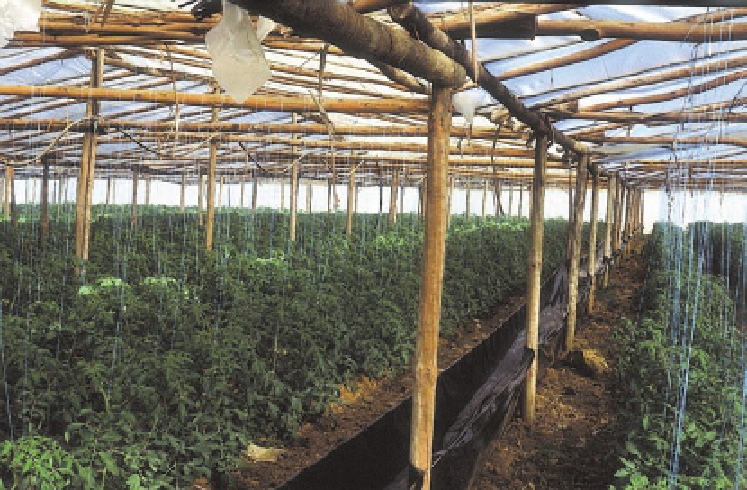Agriculture Reference
In-Depth Information
crops and attached facilities) must, prima-
rily, avoid shadows and be as cheap as pos-
sible, in terms of building and maintenance
costs, and be consistent with the agronomic
requirements.
In general, the cheaper cladding materi-
als (flexible films) have a short lifespan, so
they must be replaced more frequently than
the long-life materials (semi-rigid panels,
glass) which are more expensive and heav-
ier, requiring, therefore, more expensive
structures. As indicative figures, for the
Spanish Mediterranean coast conditions, a
glasshouse would need a metallic structure,
which weighs 15 kg m
−2
, whereas a struc-
ture for a semi-rigid panel would weigh
around 12 kg m
−2
and for a PE film around
7 kg m
−2
. From the grower's point of view,
the main aspect to consider when choosing
between the different types of greenhouses
is the annual cost per unit greenhouse sur-
face (amortization plus the maintenance
costs) depending on the performance of the
greenhouse. The cost and availability of
labour also notably influence the periodic
replacement of the plastic film.
The greenhouse structure includes the
foundations and the elements to hold the
cladding material and support the structure
itself.
To hold the cladding material, in glass-
houses or in greenhouses with semi-rigid
panels, aluminium has the advantage of
being able to be used to create difficult pro-
files, but it is expensive. In plastic green-
houses, such as the low-cost parral-type
greenhouse, wire (steel or galvanized)
fulfils this role well.
The use of wood, nowadays, is lim-
ited to straight-roof structures (Photo 4.4),
due to the difficulty and high cost associ-
ated with its use on curved sections.
Metal, on the contrary, adapts well to
curved structures, and due to its better
resistance characteristics, bears strong
forces. Today, wood is used almost only
for plastic-film greenhouses, or artisan
construction.
In plastic-film greenhouses, the choice
of structural materials is linked to: (i) their
availability and cost; (ii) their technical
characteristics depending on the green-
house to be built (use of wood, steel); (iii) the
performance required by the greenhouse
depending on the crops to be grown;
(iv) the local climate; and (v) the local
conditions in terms of experience and cre-
ativity (the parral greenhouse originated
when a plastic film was adapted to cover a
table-grape growing structure, 'pergolato').
Photo 4.4.
Wood has frequently been used in greenhouse structures in many areas.

